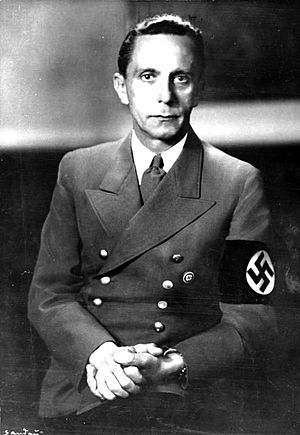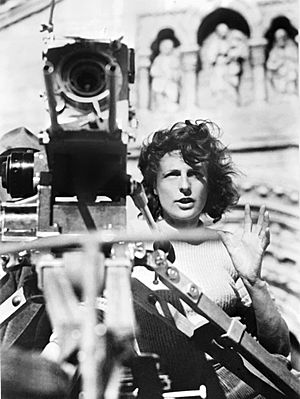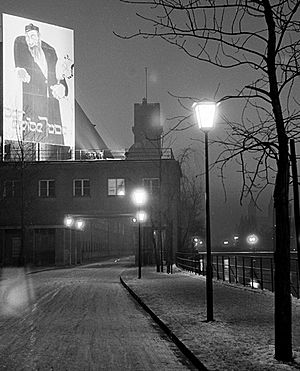Reich Ministry of Public Enlightenment and Propaganda facts for kids
The Reich Ministry for Public Enlightenment and Propaganda (in German: Reichsministerium für Volksaufklärung und Propaganda, or RMVP) was a very important government office in Nazi Germany. It controlled almost everything people saw, heard, and read. This included newspapers, books, movies, plays, music, and radio.
This ministry was created in March 1933, soon after the Nazi Party took power in Germany. Its main job was to spread Nazi ideas and control what information the public received. Joseph Goebbels was the minister in charge. He used this ministry and another group called the Reich Chamber of Culture to control all German media and artists.
| Reichsministerium für Volksaufklärung und Propaganda (German) | |
 |
|
 Propaganda Minister Joseph Goebbels in 1942 |
|
| Ministry overview | |
|---|---|
| Formed | 14 March 1933 |
| Dissolved | 2 May 1945 |
| Jurisdiction | Government of Nazi Germany |
| Headquarters | Ordenspalais Wilhelmplatz 8/9, Berlin-Mitte 52°30′45″N 13°23′1″E / 52.51250°N 13.38361°E |
| Employees | 2,000 (1939) |
| Annual budget | 14 million ℛℳ (1933) (€Error when using : |start_year=1933 (parameter 3) is lower than the earliest available year (1951) in index "DE". million in 2021)187 million ℛℳ (1941) (€Error when using : |start_year=1941 (parameter 3) is lower than the earliest available year (1951) in index "DE". million in 2021) |
| Ministers responsible | |
| Child agencies |
|
Contents
How the Ministry Started
After the March 1933 elections, Adolf Hitler wanted to create this new ministry. Even though some ministers were unsure, Hitler insisted. On March 13, 1933, the German President, Paul von Hindenburg, officially created the Reich Ministry for Public Enlightenment and Propaganda.
At that time, the word "Propaganda" didn't have a negative meaning like it often does today. It simply meant spreading information. So, the ministry's name was like saying "Ministry for Culture, Media, and Public Relations."
The ministry moved into a building called the Ordenspalais in Berlin. This building was across from the main government office. Joseph Goebbels explained the ministry's goal: to "intellectually mobilize" Germany. He said it was like a defense ministry for people's minds, making them ready to support the Nazi government.
Goebbels had been the Nazi Party's propaganda leader since 1930. The new ministry brought many tasks from other government offices under its control. Its main goal was to centralize all Nazi control over German culture, media, and intellectual life.
How the Ministry Was Organized
The RMVP grew a lot over time. It started in 1933 with five departments and 350 employees. By 1939, it had 17 departments and 2,000 employees. Its budget also grew from 14 million to 187 million Reichsmarks between 1933 and 1941.
Minister Goebbels oversaw three main State Secretaries, who each managed different areas:
- State Secretary I: Handled German and foreign newspapers and magazines.
- State Secretary II: Managed the budget, laws, general propaganda, radio, film, and arts like theater, music, and literature.
- State Secretary III: Was in charge of tourism.
Film Department
The Film Department was very important for the German film industry. It worked closely with the Reich Chamber of Culture and the Reich Film Chamber. This department took over the film censorship offices that already existed.
The Film Department had several sections, including those for film laws, the film industry, foreign films, newsreels, and scriptwriting. In 1938, the German Film Academy was added. This was the first state-run school for film artists. The head of the film department also oversaw the making of certain documentaries and the German Weekly Review newsreel. He made sure these newsreels were shown in cinemas in a way that helped the Nazi message.
Controlling Media: Press, Film, and Radio
Press Conferences
The ministry controlled newspapers through daily "Reich press conferences." Journalists received detailed instructions on what to publish and how. These instructions covered many topics, even small ones. The ministry usually didn't ban things directly at first. Instead, it used a system of checking articles after they were published. Newspapers would get praise or criticism based on their content.
Journalists had to destroy these instructions after using them. Newspapers outside Berlin received them as "Confidential Information." Some newspapers tried to resist, but journalists who shared the instructions with foreign press were punished.
Film Censorship
On February 9, 1934, Goebbels called film "one of the most modern and far-reaching means of influencing the masses." This shows how important film was to the Nazis.
The head of the film department and Goebbels could suggest film ideas and scripts. They supported films that helped military or foreign policy goals. They could also stop film projects they didn't like or thought had "mistakes of taste." After a law change in 1934, films could be banned for "violating National Socialist, moral or artistic sensibilities." Every film project needed approval before filming began.
The German Weekly Review
The Film Department also managed the Deutsche Wochenschau (German Weekly Review). By 1940, these newsreels were even more influential than newspapers. Over 300 film reporters, some working with the military, gathered material. The RMVP edited and added music to this material. Besides war news, the Wochenschau presented political and cultural events in a way that supported Nazi propaganda.
These carefully made film reports were popular in cinemas and had a big impact. By 1942, the Wochenschau was shown in almost all German cinemas. It was a 20-minute compilation shown before the main movie, reaching 20 million moviegoers every week.
Radio Control
On June 30, 1933, regional radio stations were forced to join the Reich Broadcasting Corporation. This corporation was controlled by the RMVP. At Goebbels' request, it was renamed "Greater German Broadcasting" in 1939. It broadcast a single, unified program across Germany starting in June 1940.
Overlapping Responsibilities

The Propaganda Ministry's tasks sometimes overlapped with other organizations. Many of these groups were also connected to Goebbels. For example, the Reich Chamber of Culture controlled and supervised artists in theater, radio, film, and the press.
There were also power struggles between different Nazi leaders over who controlled what media. This sometimes led to confusing instructions. For the 1936 Summer Olympics, the Ministry of the Interior was officially in charge of sports. However, Goebbels got involved early on and had a lot of influence. The film Olympia by Leni Riefenstahl shows how powerful Nazi propaganda was during these games.
There were also arguments over who controlled propaganda aimed at other countries. The Foreign Ministry thought it should handle this. Goebbels and his ministry, however, kept trying to influence foreign propaganda until the end of the war.
See also
 In Spanish: Ministerio del Reich para la Ilustración Pública y Propaganda para niños
In Spanish: Ministerio del Reich para la Ilustración Pública y Propaganda para niños
- Propaganda in Nazi Germany
- Children's propaganda in Nazi Germany
- Reich Chamber of Culture
- Reich Chamber of Music
- Ministry of Popular Culture


